Cleaning - stone
War Memorials Trust is often asked about the cleaning of memorials. The section deals with the cleaning of stone war memorials.
War Memorials Trust Conservation Officers can provide advice on cleaning your memorial for example whether it needs cleaning, how it could be cleaned and whether works are eligible for funding. Please read this page alongwith the relevant helpsheets indicated as the first source of information then contact War Memorials Trust if you need further help. If you would like advice on a specific war memorial then please complete the 'Request advice or report your concern' section of the website and ensure you send photographs as directed. It is practically impossible to provide advice on cleaning a specific memorial without photographs so please do send good quality images to enable us to help you.
War Memorials Trust's approach to cleaning
War Memorials Trust only advises cleaning memorials under certain circumstances – when the dirt and deposits are disfiguring, damaging or covering inscriptions. Over-cleaning and cleaning in the wrong way can damage fragile surfaces and wear away inscriptions, damaging the memorial and reducing its lifespan. We believe in preserving the original materials of a memorial as chosen by the community who erected the war memorial. Please see War Memorials Trust’s helpsheet Conservation of stone for more information on the technical aspects of cleaning stone where our approach is outlined in more detail.
War Memorials Trust advises that people should be aware that inappropriate cleaning methods can cause far more damage to a war memorial than leaving the dirt and depsotis there. It is vital that anyone planning to clean a memorial understands what is required and the most appropriate methods to use.
Other organisations such as The Commonwealth War Graves Commission have a different approach to cleaning and people may be familiar with the sight of perfectly clean headstones. However, constant cleaning means that regular re-cutting and replacement of stone needs to take place, something which is not appropriate for historic monuments.
What kind of dirt and deposits may need to be cleaned away?
Surface deposits on memorials can consist of:
- Biological growths (lichens, algae, moss)
- Pollution (sulphates, carbonates from cars, factories etc)
- General dirt and grease
- Paint (graffiti)
- Chemical (e.g. copper sulphate staining run-off from bronze)
Who should clean a war memorial?
War Memorials Trust encourages anyone thinking about cleaning a war memorial to consider the following points:
- Who is responsible for the war memorial and keeping it clean? If you are not the owner or custodian you should try and find out if there is one and discuss the situation.
- Depending on the extent of the dirt and despoits it may be a simple task or a more complex one that should only be taken on by a specialist. Inappropriate cleaning can cause more damage than leaving the dirt there. If you are unsure you should consult a professional or ask War Memorials Trust for advice.
Does your war memorial need to be cleaned?
This page introduces examples of stone memorials which have different levels of dirt and surface deposits to provide advice on when cleaning is appropriate.
The images are designed to help you identify whether your memorial needs cleaning. Each images gives the status in relation to the dirt and deposits, how these could be cleaned and by who, the opinion of the Trust in relation to this case and whether such cleaning could be considered for grant funding.
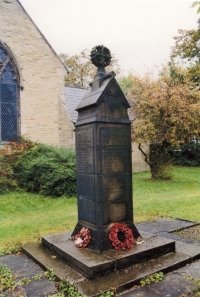 Senario 1
Senario 1
Status
A very dirty war memorials with heavy deposits of pollution. The inscriptions are illegible.
How to clean
This should be cleaned by a professional using specialist techniques as cleaning with the wrong methods may cause long-term damage. War Memorials Trust Conservation Officers can advise on appropriate action.
War Memorials Trust position
Cleaning is justified to ensure the inscriptions can be read. The dirt and deposits may be damaging the memorial in the long-term.
Grant eligibility
Would be considered for a grant as a high priority as the dirt and deposits may be damaging memorial and preventing the inscription being read.
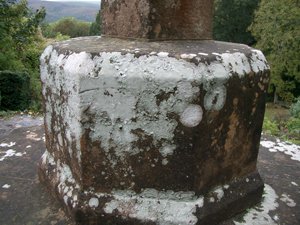 Scenario 2
Scenario 2
Status
Heavy deposits of lichen on the war memorial which are NOT covering any inscriptions or causing damage.
How to clean
The memorial does not need to be cleaned at present. Lichens are not proven to do any damage but removing them can cause problems for example if the lichens pull pieces of stone off. If the lichen spreads and start to cover inscriptions or cause problems then action to remove them appropriately can be considered. War Memorials Trust can advise on appropriate methods or further information can be found in the helpsheet 'Lichens' and 'Biocides and detergents'.
War Memorials Trust position
If lichen is removed there is a chance that stone will come with it during the removal process. This can cause more damage then leaving the lichen which is a natural growth commonly occurign on stone which is not proven to cause damage. The Trust would support the removal if inscriptions or names were being covered and could no longer be read.
War Memorials Trust would recommend regular monitoring of the growth as part of a maintenance programme. For example photographing the areas covered by lichen so any spread could be assessed.
Grant eligibility
Not considered for a grant at the moment but may be in future.
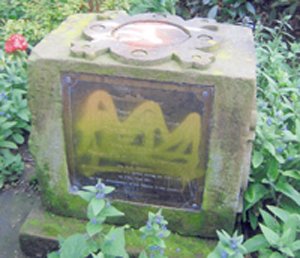 Scenario 3
Scenario 3
Status
Heavy covering of graffiti on the memorial. Most of inscription is illegible.
How to clean
Removing graffiti is a complex issue and treatments will depend on the materials involved. War Memorials Trust Conservation Officers can advise on appropriate action.
War Memorials Trust position
The graffiti needs to be removed as it is covering the inscription on the memorial and causing offence. The graffiti should be removed by someone who understands the material to be treated.
War Memorials Trust would recommend considering measures that might prevent future graffiti. Some of the principles in the 'War Memorial Theft: Prevention and solutions' helpsheet may be applicable.
Grant eligibility
Would be considered for a grant as a high priority because the inscription cannot be read.
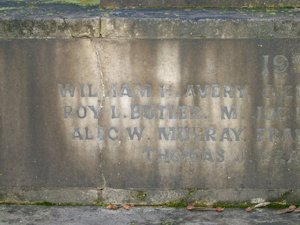 Scenario 4
Scenario 4
Status
Heavy deposits of pollution and staining to the marble. The inscription is difficult to read and cleaning is required
How to clean
Removing dirt and deposits is a complex issue and treatments will depend on the materials involved. War Memorials Trust Conservation Officers can advise on appropriate action.
War Memorials Trust position
As the inscription is difficult to read and the dirt and deposits are substantial then cleaning should be carefully undertaken probably by a professional with expertise in this type of work.
Grant eligibility
Would be considered for grant as a high priority because the inscription cannot be read..
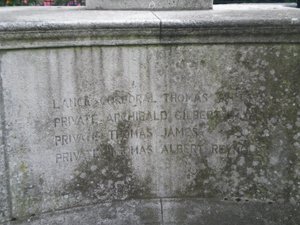 Scenario 5
Scenario 5
Status
Moderate deposits of pollution and algae on some areas. Some of the inscriptions are not legible so cleaning is necessary.
How to clean
Removing dirt and deposits is a complex issue and treatments will depend on the materials involved. War Memorials Trust Conservation Officers can advise on appropriate action.
War Memorials Trust position
As the inscription is becoming difficult to read because of dirt and deposits then cleaning should be carefully undertaken probably by a professional with expertise in this type of work. Any work undertaken will have to carefully balance the need to clean the areas covered by dirt and deposits without causign any unnecessary damage to the areas that are free of dirt and deposits.
Grant eligibility
Would be considered for grant but as a lower priority if compared with other memorials where dirt and deposits are completely covering the inscriptions or causing damage to the memorial.
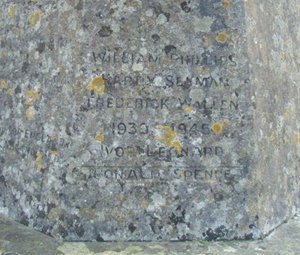 Scenario 6
Scenario 6
Status
Minimal deposits of lichen and dirt. All or most of the inscription is legible. It does not require substantial, professional cleaning at this time.
How to clean
A good maintenace plan should include simple, safe cleaning on a regular basis, perhaps annually, depending on the war memorial and its location. This will keep lichen and dirt to a minimum without damaging the war memorial stone.
This type of cleaning would be by hand using water and a natural bristle brush. No chemical or household products should be added to the water as they can get into the stone structure and cause problems.
War Memorials Trust position
All war memorials should have a basic maintenance plan which includes regular monitoring of the war memorial to identify any problems early and to oversee basic works to prevent problems occuring. A stone war memorial should be cleaned by hand with water and a natural bristle brush to prevent the build up of dirt and deposits. This should not cause damage and ensure dirt and deposits do not build up requiring major works which carry with them an increased risk of damaging the memorial.
Cleaning should only be done when required. Advice can be given by the Trust on when it is appropriate and regular monitoring by the custodian (either directly or through volunteers) can help identify how often it should be cleaned. It may be once every three years, annually or once every six months depending on where the memorial is located.
Cleaning by hand with water and bristle brushes can be undertaken by the custodian or volunteers.
Grant eligibility
Not considered for grant as it should be part of a regular maintenance programme see the Trust's helpsheets 'Looking after your war memorial' and 'Advice on maintenance of war memorials'.
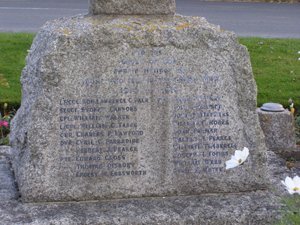 Scenario 7
Scenario 7
Status
Minimal deposits of dirt. All or most of the inscription is legible. It does not require substantial cleaning but the lettering could be re-painted.
How to clean
A good maintenace plan should include simple, safe cleaning on a regular basis, perhaps annually, depending on the war memorial and its location. This will keep lichen and dirt to a minimum without damaging the war memorial stone.
This type of cleaning would be by hand using water and a natural bristle brush. No chemical or household products should be added to the water as they can get into the stone structure and cause problems.
The maintenance plan should also monitor the condition of any painted lettering. When lettering beings to fade or paint flakes off it should be addressed by the custodian and re-painted with appropriate paint.
War Memorials Trust position
All war memorials should have a basic maintenance plan which includes regular monitoring of the war memorial to identify any problems early and to oversee basic works to prevent problems occuring.
If a memorila includes painted inscriptions then the paint should be monitored. If it starts to fade or flake action should be taken.
A stone war memorial should be cleaned by hand with water and a natural bristle brush to prevent the build up of dirt and deposits. This should not cause damage and ensure dirt and deposits do not build up requiring major works which carry with them an increased risk of damaging the memorial.
Cleaning should only be done when required. Advice can be given by the Trust on when it is appropriate and regular monitoring by the custodian (either directly or through volunteers) can help identify how often it should be cleaned. It may be once every three years, annually or once every six months depending on where the memorial is located.
Cleaning by hand with water and bristle brushes can be undertaken by the custodian or volunteers.
Grant eligibility
Not considered for a grant as re-painting lettering and basic cleaning should be part of a regular maintenance programme see the Trust's helpsheets 'Looking after your war memorial' and 'Advice on maintenance of war memorials'.



